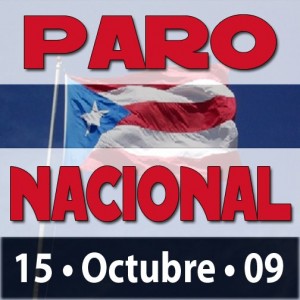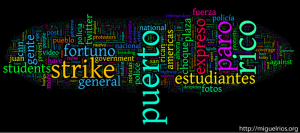They are calling themselves “Twittericans.” They are Puerto Ricans, national and transnational, who absolutely adore Twitter. Computer Science graduate student and digital media savant Miguel Ríos (@miguelrios) has written a brief history of Twitter in Puerto Rico in his blog on all things tech Novéltica [ES]. Ríos explains that Twitter started to have followers in Puerto Rico in 2008. This is when the hashtag #twittericans emerged.
El nombre de #twittericans comenzó a surgir, y nació una comunidad que en ese momento era unida, libre de toda controversia y bien amigable (cuanto extraño esos tiempos, coño).
The name #twittericans started, and a community was born. At that moment this community was close, free of controversies, and very friendly (dammit I really miss those times).

Design by Miguel Ríos.
In 2009, many famous Puerto Rican artists opened their accounts, such as Calle 13, Daddy Yankee, Ricky Martin, and Kany García. In 2009, Twitter also became an important space for spreading news. This was the year in which Twitter exploded in Puerto Rico:
Durante este año, Twitter fue parte de reportajes de periódico en la isla, y más allá, fue una de las fuentes de información más grande para las revistas y periódicos sobre información de los artistas. Ricky Martin mostró por primera vez las fotos de sus hijos vía Twitter. Locutores radiales comenzaron a integrar Twitter en sus programas. Muchas noticias fueron primero divulgadas vía esta red y luego tomadas por la prensa.
During this year, Twitter was mentioned in newspaper articles. Moreover, it became one of the major sources of information on artists for magazines and newspapers. Ricky Martin used Twitter to show the first pictures of his children. Radio reporters began to use Twitter in their programs. A lot of news stories were spread through Twitter first, and then picked up by the mainstream media.

National strike avatar used for Twitter.

These were the most frequent words used in the tweets on the national strike.
But Twitter really became a vital space of conversation and information exchange during the national strike on October 15 2009 (please check Global Voices’ coverage of the strike here, here, and here).
Durante la marcha del pueblo en contra de los despidos de empleados públicos por parte del gobierno. Twitter fue ampliamente utilizado para opinar sobre la protesta, así como también fue utilizado para protestar. Según un análisis realizado por este servidor, durante ese día se enviaron unos 2570 tweets públicos que contenían el hashtag oficial de la protesta: #paropr. Esto solo contando tweets enviados desde las 10 AM, por lo que no oficialmente me atrevo a decir que más de 5,000 tweets en total fueron escritos sobre el tema.
During the rally against the lay-offs of government employees, Twitter was widely used to express opinions on the protests, and it was also used as a protest tool in itself. According to an analysis I did at the time, during the day of the strike 2,570 tweets with the official hashtag #paropr were sent. These are only the tweets sent from at 10 am on, so I dare say unofficially that more than 5,000 tweets were written about this topic.
“Twittericans” also used Twitter a lot during the waking hours of the oil refinery explosion on October 23, 2009. Ríos once again studied the trends on Twitter, and concluded that 150 tweets with the hashtag #explosionpr were sent per hour.
No fue hasta 1 hora y 54 minutos después de la explosión que se registró la primera señal en vivo de la noticia en la televisión boricua. Sin embargo, esta señal consistía de un video de la explosión, sin audio, sin reportajes. Mientras tanto, en Twitter, ya se había corrido la voz, al punto que fue donde primero se aclaró un rumor que había llegado a Notiuno sobre la posibilidad de que un avión comercial se había estrellado y causado la explosión.
The TV arrived at the scene an hour and 54 minutes after the explosion. Anyway, the TV stations only broadcast video without audio or live reporting. In the meantime, everyone already knew about the explosion through Twitter, to the point that it was the first place in which the rumor about the explosion being caused by an airplane crash was denied.
Ríos’ next project is to quantify the Twittericans. The real time search engine of what's happening in Puerto Rico TuitealoPR estimates that there are 9,000 “Twittericans.” If you want to find Puerto Ricans on Twitter this is a great place to start: Puerto Rico Twitter Pages.
*The images are republished with the permission of Miguel Ríos.







4 comments
Thanks for this excellent article. Is an honor to see this in Global Voices.
A sus órdenes siempre,
Miguel
Twitter has really evolved into an awesome utility for building and maintaining community and spreading news.
The #twitterican tag is another great example of the community building at work.
I am glad to hear that is has not devolved into madness, as (too often) they tend to do. Beacause, like Miguel Ríos (@miguelrios) I enjoy the discussion without the controversy!
Ben (@carib_amphib)
Excelente reconocimiento y nos reafirma la importancia de seguir adelante.
Hugs and congratulations!